Introduction
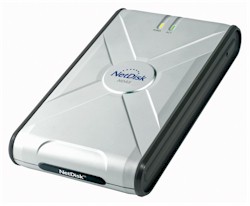
| Ximeta NetDisk | |
|---|---|
| Summary | External hard drive supporting USB 2.0 and Ethernet interfaces. Does not function as full NAS device. |
| Update | 5/1/2004 – Version 3 driver supports multi user write mode (WinXP / 2000 only). Supports single user write for MacOS X, Linux Red Hat, Win98SE, ME, CE |
| Pros | • Supports both USB and Ethernet connection • Models from 80 to 160GB |
| Cons | • XP and 2000 only • Limited as a network storage device |
USB 2.0 external hard drives are an increasingly popular way to add more storage space in a relatively painless way. And even if your USB port supports only the slower 1.1 standard, you can still use the drives – although transfers will take longer.
Ximeta’s NetDrive puts a unique twist into the external USB HDD market by adding an Ethernet port that lets you share the drive on your Ethernet LAN. I found that the NetDrive lived up to Ximeta’s claims, but also that Ximeta’s NDAS (Network Direct Attached Storage is no substitute for NAS (Network Attached Storage).
Features
The NetDrive comes in a surprisingly large aluminum case about the size of a VHS bulk tape eraser and weighs in at a hefty 3 pounds. So you’re not gonna be slipping this puppy into your pocket to haul your files around! My test unit was an 80GB 7200RPM drive (Samsung SP0802N), but 120, and 160GB versions are also available.
There are Power and ACT LEDs on the top rear of the case and the USB, 10/100 Ethernet and 4 pin DIN-style Power connector are lined up on the rear panel. There are also two dipswitches on the rear panel, which must be manually set – and the drive power-cycled – to switch between USB and NDAS mode.
Two nits are that the power connector requires a good deal of force to insert and remove and that the ACT light works only in the NDAS mode. The power connector force is noted in the install procedure, but I still felt that I was going to push in the rear panel in order to get it properly seated.
So what’s this NDAS I keep referring to? It stands for Network Direct Attached Storage and is Ximeta’s method for attaching a hard drive to an Ethernet LAN without implementing a full-blown server to manage access to the disk. Sounds great in theory, but the implementation won’t satisfy buyers looking for features found in NAS products – or at least it didn’t satisfy me! However, one plus from the absence of a server is that the NetDrive is very quiet in operation since no fans are used.
Setup and Administration
The first tip-off that you’re not dealing with a NAS device is the NetDisk’s Win2000 / XP-only requirement. The FAQ on Ximeta’s website says they’ll release “beta software for Windows 98SE and Macintosh OS X at the end of September (2003)” but there’s no mention of support for Linux or other OSes.
The other “gotchas” – also listed in the FAQ – are that “there is an issue with Hyperthreading and Dual Processors” and that the NetDisk must be used with a 100Mbps/full duplex capable switch in NDAS mode. I learned about the first problem the hard way, suffering through two days of unexplained lockups in my recently acquired desktop – which happens to use a 2.4GHz P4 with Hyperthreading!
Beta firmware (Version 2.1.4) is now available on Ximeta’s downloads page, and it appears to fix the lockup problem on my P4/HT system. But note this Beta doesn’t have the promised Win98 and MacOS X support.
Setup depends on the OS and mode you’re using. If you just want to run it as a USB device and are running WinXP, just plug it in and you won’t even have to install drivers. If you’re running Win2000, you’ll need the drivers on the install CD.
After installation completes, you should be able to see the drive in My Computer – Drive I in Figure 1.
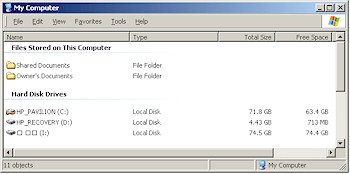
Figure 1 – The installed NetDisk
If you want to connect via Ethernet, you’ll need to run the Windows-based installer. Figure 2 shows your choices, with each one presenting a series of screens that takes you through the steps for that particular mode.
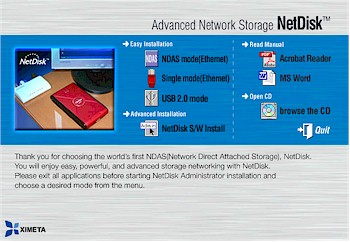
Figure 2 – Installer choices
Ximeta did a nice job on the Installer, which walks you through connection and other details of each type of setup. I connected the NetDisk to my LAN’s switch and selected the NDAS (Ethernet) option since that’s the unique part of what the NetDisk is offering, but didn’t get a successful install unless I ran it twice. I found the NetDisk S/W Install choice the most reliable and after a mandatory reboot found the NetDisk Administrator icon on my Desktop and running in the System Notification (Tray) area.
TIP: The 2.1.4 Beta software installer seems more robust and has eliminated the mandatory reboot – at least on XP systems.
Ximeta’s NDAS doesn’t make the NetDisk a true NAS device accessible through My Network Places / Network Neighborhood, but instead installs a NetDisk SCSI and RAID controller that shows up in Device Manager (Figure 3).
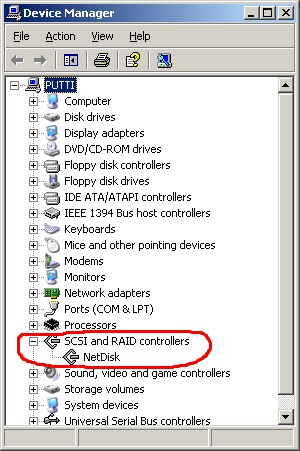
Figure 3 – Device Manager entry
The NDAS mode allows multiple LAN clients read access to the NetDisk, but only one client at a time has full read/write access. This process is managed by the Administrator program, which must be installed on each system in order to access the NetDisk. The Administrator also allows you to register a new disk as shown in Figure 4 by entering information from a label on the bottom of each NetDisk.
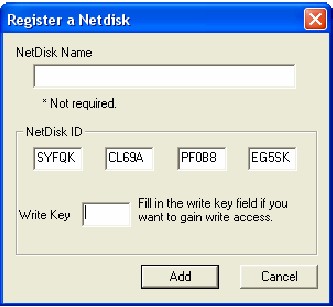
Figure 4 – NetDisk Register
Right-clicking the NetDisk Administrator icon in the System tray pops up a color-coded status indicator among its menu items, but I didn’t find it very helpful since there are seven different colors and no on-line help to tell you which is which! I found the Administrator’s Properties menu shown in Figure 5 much more helpful for figuring out what the NetDisk was up to.
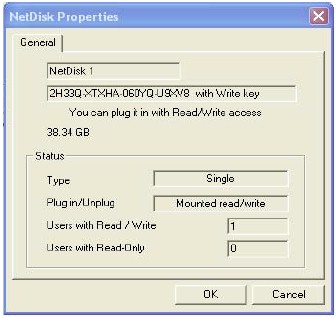
Figure 5 – NetDisk Properties
I didn’t like the Read/Write control system at all. There’s no ability to prevent users from freely grabbing write access and when access changes you get only an audio indication and no pop-up message or warning. I can see where this system could easily frustrate users in even a small work-group. There should at least be a way to lock write privileges to a single client, or require a password to obtain it.
In addition to the Administrator program, Ximeta supplies an Aggregation and Mirroring utility. As its name implies, you can use it to get multiple NetDisks to appear as one, or to mirror each other, but I didn’t try it out since I had only one NetDisk to play with.
Performance
I generally dislike using Windows drag-and-drop file transfers to evaluate product performance because it’s such a black box with large overhead that produces widely varying results. But I didn’t really have much choice given the nature of the product.
My test client was a 2.4GHz Pentium 4, running WinXP Home with 512MB RAM and Realtek RTL8139 10/100 PCI Ethernet. The NetDisk was connected to my LAN’s 10/100 switch operating in full duplex mode.
I used a folders each containing the same 54.4MB of assorted gif and jpg files and used a stopwatch to time the transfers from the time I dropped the file until the file transfer progress bar disappeared. No other applications were running on the client. Each test was run three times and I deleted the transferred folder and emptied the Trash after each run. Table 1 shows the averaged results from my test runs.
|
Test
|
Transfer Time (sec.) |
Transfer Rate
(MB/sec) |
|---|---|---|
| NDAS mode – Client to NetDisk |
17
|
3.3
|
| NDAS mode – NetDisk to Client |
11.7
|
4.8
|
| USB 2.0 mode – Client to NetDisk |
11
|
5.1
|
| USB 2.0 mode – NetDisk to Client |
12.7
|
4.4
|
|
Table 1: File Transfer Test results
|
||
Although the numbers seem to give a slight performance edge to the USB 2.0 mode, I think they’re within the range of variation of the drag-and-drop measurement technique. Basically, you can choose Ethernet or USB2.0 connection without worrying about slowing your transfer speed.
Closing Thoughts
Judging from the glowing reviews the NetDisk has received on other sites, I might be considered a party-pooper, but I wasn’t that impressed with the NetDisk. When considered as a USB 2.0 drive, the NetDisk can cost you as much as $50 more than a plain USB 2.0 80GB drive, and it’s certainly less portable than some of its bretheren. As a network device, its one-writer-at-a-time limitation and inability to control who grabs write privileges make it useful only in very limited networked scenarios.
If you think of the NetDisk as an external USB 2.0 drive that can also connect to your computer via Ethernet and don’t mind paying a premium, you’ll probably be happy with your purchase. But if you’re looking for a NAS box at a bargain price, you won’t find it in this product.
